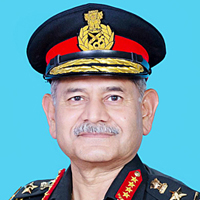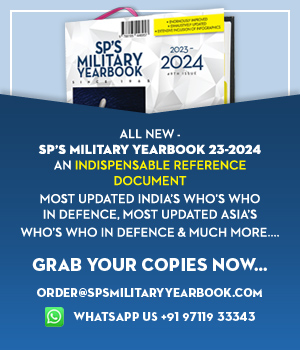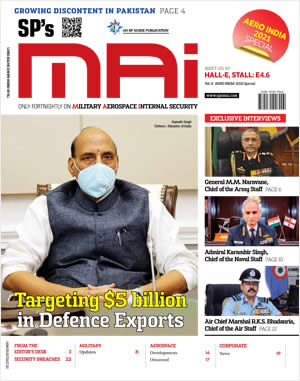INDIAN ARMED FORCES CHIEFS ON OUR RELENTLESS AND FOCUSED PUBLISHING EFFORTS

The insightful articles, inspiring narrations and analytical perspectives presented by the Editorial Team, establish an alluring connect with the reader. My compliments and best wishes to SP Guide Publications.

"Over the past 60 years, the growth of SP Guide Publications has mirrored the rising stature of Indian Navy. Its well-researched and informative magazines on Defence and Aerospace sector have served to shape an educated opinion of our military personnel, policy makers and the public alike. I wish SP's Publication team continued success, fair winds and following seas in all future endeavour!"

Since, its inception in 1964, SP Guide Publications has consistently demonstrated commitment to high-quality journalism in the aerospace and defence sectors, earning a well-deserved reputation as Asia's largest media house in this domain. I wish SP Guide Publications continued success in its pursuit of excellence.
- The layered Air Defence systems that worked superbly, the key element of Operation Sindoor
- Operation Sindoor | Day 2 DGMOs Briefing
- Operation Sindoor: India strikes back with Precision and Purpose
- Operation Sindoor: Resolute yet Restrained
- India’s Operation Sindoor Sends a Clear Message to Terror and the World – ‘ZERO TOLERANCE’
- Japan and India set forth a defence cooperation consultancy framework, talks on tank and jet engines
- Terrorist Attack in Pahalgam in Kashmir: Unfolding a long surgical war against PAK
- Lt General Pratik Sharma takes over Command of Indian Army's Northern Command
ARL, Purdue University research of 3-D printing to fix damaged on-the-spot in combat zones
New technology being developed by research engineers at the US Army Research Laboratory and Purdue University will soon help just about any soldier deployed in far-off locations to immediately spot and fix damaged aircraft and ground vehicle parts.
Researchers found that combining the general purpose, finiteelement analysis software ABAQUS with Python, an open-source code used to optimise logical structures such as topologically interlocked structures, improves energy absorption and dissipation, productivity and lower maintenance costs.
The combination of ABAQUS and Python provides an automated process for auto-generation of the geometries, models, materials assignments and code execution, said Ed Habtour, a research engineer with ARL’s Vehicle Technology Directorate at Aberdeen Proving Ground.
He said the code is developed to assist designers with tools to model the new generation of 3-D additive manufactured and TISs structures.
“The benefit for the soldier is an after-effect. The TIS would provide an excellent energy absorption and dissipation mechanism for future vehicles using additive manufacturing, Habtour said. “Subsequently, the soldier can print these structures in the field using additive manufacturing by simply downloading the model generated by the designer/vendor.”
The research team developed logical structures from the mini-composition of tetrahedron-shaped cells in existing materialsan approach ARL research engineers say is a vast departure from the military’s tendency to build new materials to meet existing problems.
“Traditionally, every time the US Army encounters a problem in the field the default has been to develop new and exotic materials. Using logical structures can be effective in solving some critical and challenging problems, like the costly and time-consuming certification process that all new materials must face,” Habtour said.
This logical structure is based on principles of segmentation and assembly, where the structure is segmented into independent unit elements then reconfigured/assembled logically and interlocked in an optimal orientation to enhance the overall properties of the structure, Habtour explained.
The researchers are focusing on topologically interlocked structures using VTD’s 3-D additive manufacturing approach to build 2-D and 3-D structures based on cells in the shape of Platonic solids.
Habtour said new structures created from this process are designed to be adaptive and configurable to the harsh conditions like random and harmonic vibrations, thermal loads, repetitive shocks due to road bumps, crash and acoustic attenuation. An added bonus he said is that these structures are configured to prevent crack propagation.
“Sometime in the near future, soldiers would be able to fabricate and repair these segmented structures very easily in the front lines or Forward Operating Bases, so instead of moving damaged ground or air vehicles to a main base camp for repair, an in-field repair approach would essentially mean vehicles would be fixed and accessible to warfighters much faster at lower costs,” said Habtour. “We want to change the conventional thinking by taking advantage of exciting materials and manipulating the structure based on the principle of segmentation and assembly.”
ARL is working closely with project managers at the US Army Aviation and Missile Research Development and Engineering Center. Discussions are already under way to transition this work to AMRDEC and Tank Automotive Research, Development and Engineering Center developmental programmes.





